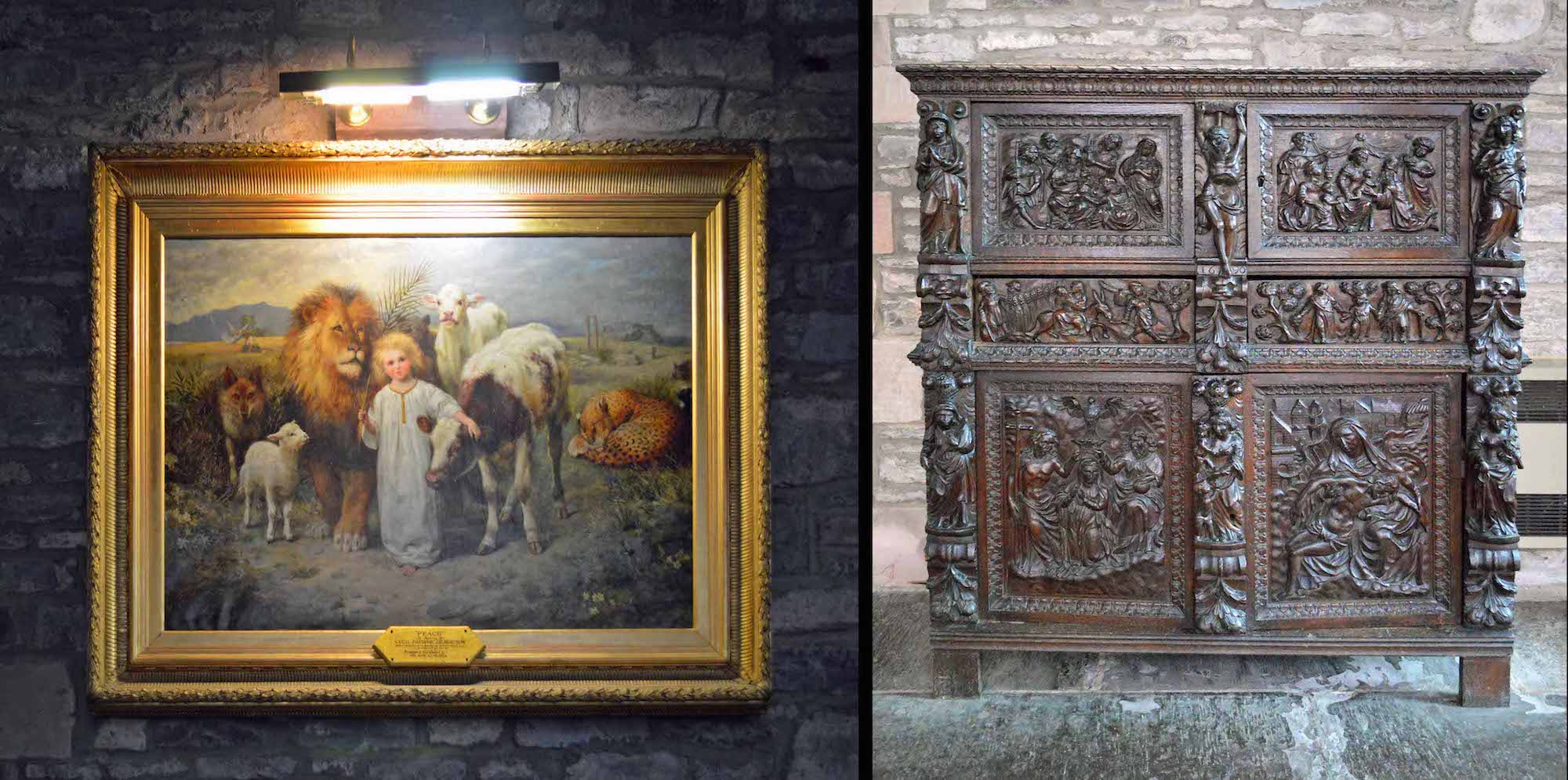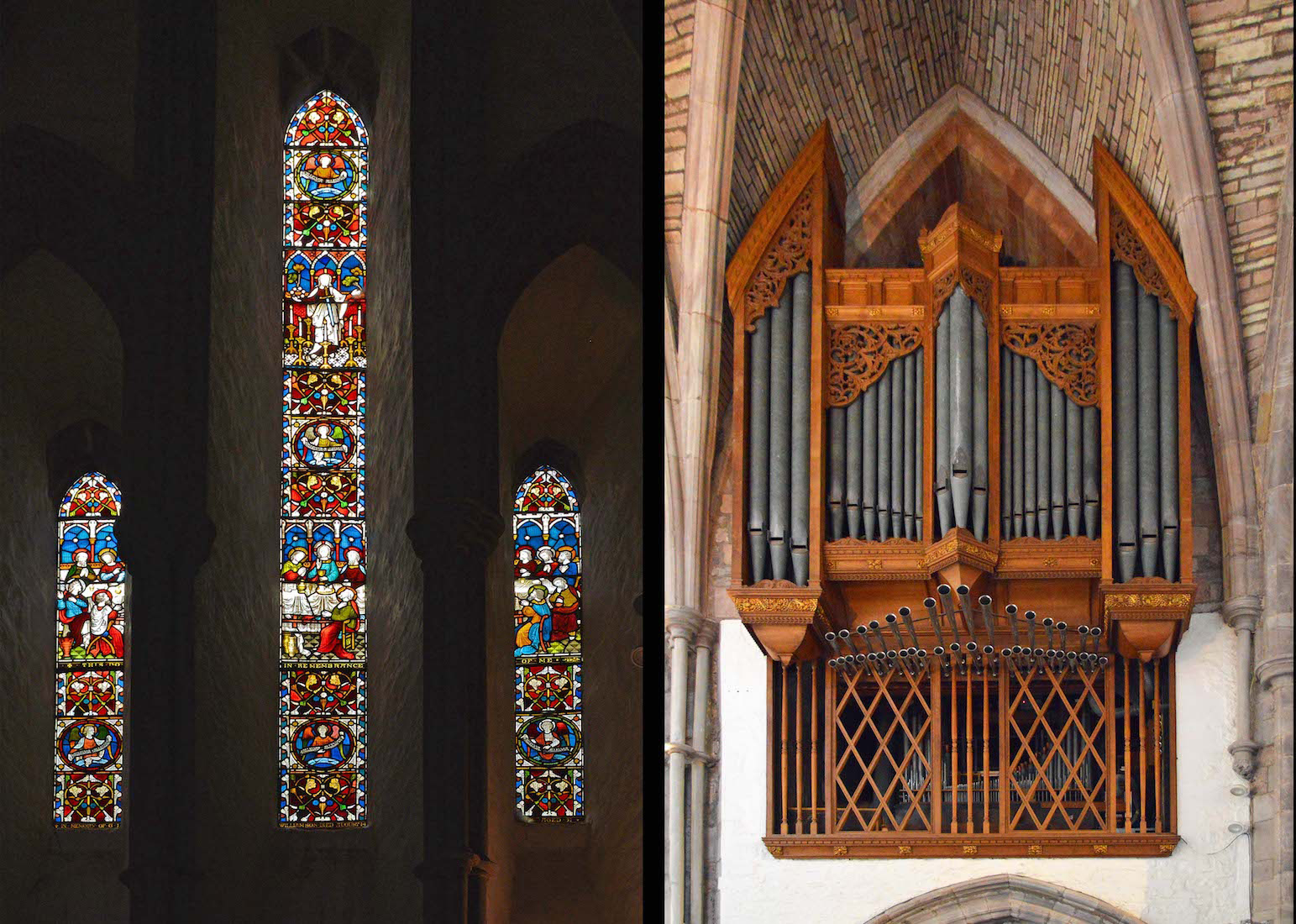
There are a couple of display tables along the South wall of the nave. I am amazed to discover on this table a Roll of Archers from the Lordship of Brecknock [Brecon] who served at Agincourt. The Battle of Agincourt was one of the greatest English victories in the Hundred Years’ War. It took place on 25 October 1415 (Saint Crispin's Day) near Azincourt in northern France. PLAN
42. SOUTH NAVE

Looking along this wall further towards the West, we find another table – this one with books and pamphlets. Just beyond is a glimpse of a tomb.
43. SOUTH NAVE WINDOWS
There are just two windows in this South wall. The window at left shows Christ as the Good Shepherd, carrying two lambs. The window to the right shows Christ appearing from the tomb. The centurion and soldiers are struck down with fear. Christ is holding the banner of St George, or perhaps the English flag!
44. WILLIAMS TOMB
The final item of interest along this wall is the 17th century tomb of Sir David Williams of Gwernyfed, and his wife. During his successful career, Williams was appointed as attorney-general for five of the South Wales counties in the Great Sessions (1581-5), recorder of Brecon and Carmarthen (1587-1604), Member of Parliament for Brecon (two terms in 1584-93 and 1597-1604) and finally as the Justice of the King’s Bench.
45. SOUTH NAVE AISLE
We next follow the South aisle up to the South transept. Looking back we see just a few of the Cathedral’s many floor slab memorials.
46. SOUTH TRANSEPT I
The Cathedral transepts are quite small in their dimension, but the South transept is bright and light with its large clear South window. The South and West walls are covered with memorials.
47. SOUTH TRANSEPT II
The East wall of the transept is taken up with a double arch: the arch at left leads through to the sacristy which is not open to the public; the right arch will take us through to the St Lawrence Chapel. At extreme left is an icon of Mary and the baby Jesus.
48. MOTHER AND CHILD
At left is an icon of the Mother and Child. We are reminded that this Cathedral exists to honour Jesus of Nazareth, who lived our life and shared our human condition. The Eastern Orthodox Church sees the Icon as a window into heaven. All Christians believe that in this Mother and her Son we are given a true and unparalleled window into heaven. Mary shows us her son Jesus, and Jesus shows us what God is like. He shows us that God is love. He reveals God to be the loving Father of all people.
50. MOTHERS’ UNION BANNERS
The St Lawrence Chapel was rebuilt in 1929 and refurbished in 1993 by the members of the Diocesan Mothers’ Union. This explains the presence of two Mothers’ Union banners near the entrance. I have been interested to learn about the Diocese of Monmouth mentioned on the banner at left. Despite the name, its cathedral is located not in Monmouth but in Newport — the Cathedral Church of St Woolos.
51. MEMORIALS AND WINDOW
The memorial tablets remember Bishop Edward William Williamson who served as bishop between 1939 and 1953. Below are the names of two members of the de Winton family who both served the Church in Wales while frequently serving as Mayor of Brecon. Directly opposite these memorials is a stained glass window with lancets depicting St Oswald and St George.
52. ST LAWRENCE CHAPEL
The St Lawrence Chapel is simply furnished wth an altar and two side pews. A stained glass window faces us from beyond the altar, and there is another window in the South (right) wall. In front of the altar is a lectern with an attractive drape, and there is a niche containing Holy Oils in a niche in the left wall.
53. CHAPEL WINDOWS
The Chapel windows are delightful. The window above the altar shows us the Wise Men coming to visit Jesus at the time of his birth. God became in Jesus a helpless child before whom the Wise Men (the three Kings) kneel in homage to the new King for God’s people. There they present gifts with wonderful and special meanings: gold, frankincense and myrrh. The single lancet on the South wall depicts the Annunciation: the angel speaking to Mary.
54. OILS AND MOTIF
The Holy Oils are kept in this chapel, for use in the Sacraments of the Church. They are Oil of the Sick for the ministry of healing; the Oil of Catechumens for the preparing for Baptism; the Oil of Chrism used as a sign of being anointed with God’s Spirit in Confirmation and Ordination. The altar frontal has an interesting motif with a gold cross and entwining vine.
55. LEAVING THE CHAPEL
As we leave the St Lawrence Chapel we observe the beautiful Last Supper scene carved at Oberammergau and the fine recumbent bronze of Edward Latham Bevan. The sculptor was W. Goscombe John. Bevan (1861 – 1934) was a Welsh churchman, the inaugural Bishop of Swansea and Brecon from 1923 until his death, having previously been the final suffragan Bishop of Swansea.
56. PAST THE SACRISTY
We walk along past the sacristy where there is a carved chest, and above it a painting. The door just beyond, shown at left, leads to the sacristy where Cathedral treasures are stored.
57. PAINTING AND CHEST
The elaborately carved chest has panels carved with scenes from the life of Christ which are probably late fifteenth century and from Neath Abbey. Above it is the picture ‘Peace’ by the Victorian artist, William Strutt, depicting the Kingdom of the Messiah as foreshadowed in Isaiah Chapter 11 – the wolf shall lie down with the lamb.
58. INTO THE CHANCEL
We come past the sacristy door and into the chancel. Looking back we can see the Bevan effigy, and the far window of the Lawrence Chapel entry. Above the arch is a set of organ pipes, and to the left of the pipes is a high stained glass window.
59. HIGH WINDOW AND ORGAN PIPES
The first organ to be installed in the Cathedral was brought here from Drury Lane Theatre in London, in 1789 and was followed by a number of replacements until the present organ by William Hill & Son was installed in 1886. This instrument has been rebuilt and enlarged several times including the re-build in 1995/6 in the course of the 900th anniversary celebrations. At this time the magnificent Fanfare Trumpet stop was added. The organ pipes are in the main organ case up on the south side of the Chancel not far from the Bishop’s throne. The shiny pipes which protrude at right angles from the organ case are the pipes of the Fanfare Trumpet. The high window shows the Risen Christ (with a sword!), the Last Supper, and three musical angels.
60. CATHEDRA
Close by the organ pipes, but at ground level, is the cathedra, or Bishop’s throne. The word ‘cathedral’ comes from the Latin and Greek word ‘cathedra’ which means ‘throne’. The throne is the symbol of the Bishop’s work as a teacher of the Christian faith, his authority, and of the unity of the Christian family which he both serves and leads. On the back of the cathedra is a cross and a Chi-Rho symbol representing Christ.




















